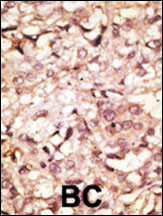



| WB | 咨询技术 | Human,Mouse,Rat |
| IF | 咨询技术 | Human,Mouse,Rat |
| IHC | 1/100-1/500 | Human,Mouse,Rat |
| ICC | 技术咨询 | Human,Mouse,Rat |
| FCM | 咨询技术 | Human,Mouse,Rat |
| Elisa | 咨询技术 | Human,Mouse,Rat |
| Aliases | Angiotensin-converting enzyme 2, ACE-related carboxypeptidase, Angiotensin-converting enzyme homolog, ACEH, Metalloprotease MPROT15, Processed angiotensin-converting enzyme 2, ACE2 |
| Entrez GeneID | 59272 |
| WB Predicted band size | 92.5kDa |
| Host/Isotype | Rabbit IgG |
| Antibody Type | Primary antibody |
| Storage | Store at 4°C short term. Aliquot and store at -20°C long term. Avoid freeze/thaw cycles. |
| Species Reactivity | Human |
| Immunogen | This ACE2 (SARS Receptor) antibody is generated from rabbits immunized with a KLH conjugated synthetic peptide between 773-805 amino acids from the C-terminal region of human ACE2 (SARS Receptor). |
| Formulation | Purified antibody in PBS with 0.05% sodium azide,1%BSA and 50% glycerol.prepared by Saturated Ammonium Sulfate (SAS) . |
+ +
以下是3篇关于ACE2抗体的代表性文献摘要概括:
1. **文献名称**:*Structural basis for the recognition of SARS-CoV-2 by full-length human ACE2*
**作者**:Yan R, Zhang Y, Li Y, et al.
**摘要内容**:该研究通过冷冻电镜解析了新冠病毒(SARS-CoV-2)刺突蛋白与人类ACE2受体结合的复合物结构,揭示了ACE2的关键结合域,为设计阻断病毒入侵的抗体或药物提供了结构基础。
2. **文献名称**:*A human neutralizing antibody targets the receptor-binding site of SARS-CoV-2*
**作者**:Wu Y, Wang F, Shen C, et al.
**摘要内容**:研究者从康复患者体内分离出一种强效中和抗体(BD-368-2),证明其能特异性结合ACE2受体上的病毒结合区域,并在小鼠模型中显著抑制病毒复制,为治疗性抗体开发提供候选分子。
3. **文献名称**:*Broad neutralization of SARS-related viruses by human monoclonal antibodies*
**作者**:Pinto D, Park YJ, Beltramello M, et al.
**摘要内容**:筛选出多种靶向ACE2结合区域的人类单克隆抗体,发现部分抗体对SARS-CoV-2及其相关病毒具有广谱中和能力,提示这类抗体可能用于应对未来冠状病毒的跨物种传播。
4. **文献名称**:*ACE2-targeting monoclonal antibody as a candidate therapy for COVID-19*
**作者**:Lei C, Qian K, Li T, et al.
**摘要内容**:开发了一种人源化ACE2单克隆抗体(h11B11),通过阻断病毒刺突蛋白与ACE2的结合,在体外和动物模型中有效抑制SARS-CoV-2感染,展示了其作为临床治疗药物的潜力。
这些研究涵盖了ACE2抗体的结构机制、中和活性评估及治疗应用方向。如需具体DOI或发表年份,可进一步补充说明。
ACE2 (angiotensin-converting enzyme 2) is a transmembrane protein widely expressed in tissues such as the lungs, heart, kidneys, and intestines. It plays a critical role in the renin-angiotensin system (RAS), regulating blood pressure and cardiovascular homeostasis by converting angiotensin II to angiotensin-(1-7). During the 2003 SARS-CoV and 2019 SARS-CoV-2 outbreaks, ACE2 was identified as the primary entry receptor for viral infection. The spike (S) protein of these coronaviruses binds to ACE2 via its receptor-binding domain (RBD), facilitating viral entry into host cells.
ACE2-targeting antibodies have emerged as key tools for studying viral pathogenesis and developing therapeutic strategies. Neutralizing antibodies against ACE2 or the viral spike protein can block this interaction, preventing viral entry. Some antibodies bind directly to ACE2’s RBD-binding interface, while others stabilize ACE2 in a conformation unfavorable for spike attachment. Research also explores engineered soluble ACE2 proteins or decoy receptors to "trap" the virus. However, therapeutic antibodies must balance efficacy with safety, as ACE2 has physiological roles in RAS signaling and gut microbiota modulation. Additionally, viral mutations in emerging variants (e.g., Omicron) may alter ACE2-binding affinity, impacting antibody effectiveness. Despite challenges, ACE2 remains a pivotal target for antiviral therapies and diagnostic tools, reflecting its dual role in infection and host physiology.
×